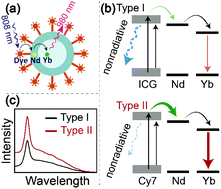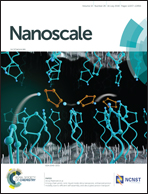An efficient dye-sensitized NIR emissive lanthanide nanomaterial and its application in fluorescence-guided peritumoral lymph node dissection†
Abstract
The luminescence intensity of near-infrared (NIR) emitting lanthanide nanoparticles (LnNPs) is usually limited, owing to their small absorption cross section. Although dye sensitization has been proven to be an effective way to improve the luminescence intensity of LnNPs, the sensitization effect is fairly limited, owing to the simplicity of the sensitizers used and the complexity of the energy transfer process, typically involving three steps. In this study, a more efficient sensitizer (Cy7) was chosen to replace a commonly used one (ICG) and the energy transfer process was also optimized through using Yb3+ ions as emitter ions and Nd3+ ions as intermediate ions. With Cy7 as a sensitizer, the sensitization effect was assessed to be better than with ICG, owing to the higher quantum yield of Cy7. Meanwhile, the Cy7-sensitized NIR lanthanide nanomaterial was proven to be good for deep tissue penetration and low-power excitation bioimaging. Furthermore, the highly-enhanced NIR signal was successfully used in blood vessel imaging and fluorescence-guided peritumoral lymph node dissection in a mouse model.

- This article is part of the themed collection: 2018 Nanoscale HOT Article Collection


 Please wait while we load your content...
Please wait while we load your content...